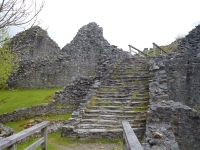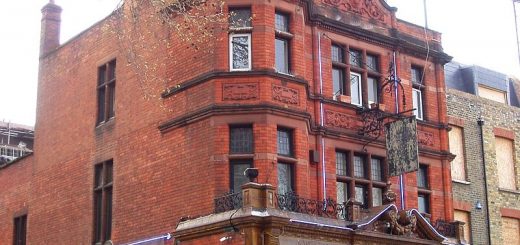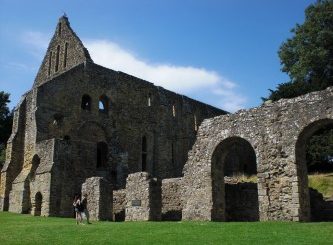Osterley Park House
Osterley Park House, which is reputedly haunted by a white lady, started as an Elizabethan mansion dating from the 1570’s, built as a country retreat by Sir Thomas Gresham (born 1519 – died 21 November 1579).
Sir Thomas Gresham’s house is described in ‘Heston and Isleworth: Osterley Park’, A History of the County of Middlesex: Volume 3 (1962): ‘The house stands on the site of a farm-house which was bought by Sir Thomas Gresham and replaced by a ‘house beseeming a prince’. Gresham’s house was completed about 1577 and he entertained the queen there at least twice. On one occasion he had the ‘court’ of the house divided in two by a wall on her suggestion, and this has been taken to confirm that Gresham’s house, like the present one, was built round four sides of a court-yard. Glover’s map of 1635, however, seems rather to depict a house built as an H or half-H, with a double court-yard (possibly that referred to in the story mentioned above) in front (i.e. on the north-east). The four corner-turrets of the present building, with their ogee turrets, almost certainly survive, refaced, from Gresham’s house. Virtually nothing more is known of the house, save that it had a private chapel, and remained largely unchanged until the 18th century. The only one of Gresham’s buildings to survive in approximately its original form is the stable block, which consists of a half-H of two stories with semioctagonal stair-turrets in the angles.’
![Jim Linwood [CC BY 2.0 (https://creativecommons.org/licenses/by/2.0)], via Wikimedia Commons](http://www.mysteriousbritain.co.uk/wp/wp-content/uploads/2018/11/800px-Osterley_Park_House_London-25June2009_2-300x171.jpg) In 1711 the house which was then in a poor state of repair came into the possession of the banker Sir Francis Child (who had also served as Lord Mayor of London and a Member of Parliament) in settlement for a loan to Nicholas Barbon, a building speculator who had acquired Osterley in 1683. Unfortunately he never lived at Osterley, dying two years later. Sir Francis had three sons who took over his bank, Child & Co, but it was his grandson, also called Francis Child (born 1735 – died 1763) who in 1761 commissioned Robert Adam (born 3 July 1728 – died 3 March 1792) the architect and interior designer to remodel Osterley which was now the family seat.
In 1711 the house which was then in a poor state of repair came into the possession of the banker Sir Francis Child (who had also served as Lord Mayor of London and a Member of Parliament) in settlement for a loan to Nicholas Barbon, a building speculator who had acquired Osterley in 1683. Unfortunately he never lived at Osterley, dying two years later. Sir Francis had three sons who took over his bank, Child & Co, but it was his grandson, also called Francis Child (born 1735 – died 1763) who in 1761 commissioned Robert Adam (born 3 July 1728 – died 3 March 1792) the architect and interior designer to remodel Osterley which was now the family seat.
Francis died two years later in 1763 and his brother Robert Child (born 1739 – died 1782) continued working with Adam’s and implemented his plans for the long term total remodeling of Osterley. The last of Adam’s designs for Osterley dates from 1780 and he house has been hardly changed since his schmes were completed.
Adam rebuilt the house round a courtyard of which the centre of the north-west side was left open and spanned by a great Ionic portico. The portico was inspired by Wood’s engravings of the Temple of the Sun at Palmyra, though at Osterley Adam used this feature as a colonnaded screen rather than as an entrance. It gives access to the courtyard, which Adam raised to firstfloor level, and across which lies the principal entrance to the house. Apart from the portico Adam left the exterior very plain, casing it with red brick and rearranging the windows in three regular ranges beneath a balustraded parapet. Inside, a series of state apartments was made on the first floor, where only the gallery and breakfastroom were retained from the previous house. The seven other state rooms were all, with much of their furniture, designed by Adam, and provide a wide range of his style. ‘Heston and Isleworth: Osterley Park’, A History of the County of Middlesex: Volume 3 (1962).
Robert Child invested a lot of money and time in remodeling Osterley and after he passed away in 1782, his wife, Sarah, continued his work and remained at Osterley a further ten years. Robert’s daughter Sarah married the Tory politician John Fane, 10th Earl of Westmorland (born 1 June 1759 – died 15 December 1841) at Gretna Green on 20th May 1782 after eloping without Child’s permission. Robert Child died a few months later, disinheriting his daughter, he left his estate and Osterley to their daughter, his as yet unborn granddaughter, Lady Sarah Sophia Fane (born 4 March 1785 – died 26 January 1867). On 23 May 1804 Lady Sarah married George Child-Villiers, 5th Earl of Jersey (born 19 August 1773 – died 3 October 1859).
By the mid 1800’s Osterley House was no longer a main residence. Between 1870 and 1883, Osterley was rented by the Dowager Duchess of Cleveland. George Francis Child Villiers, 9th Earl of Jersey (born 15 February 1910 – died 9 August 1998) inherited Osterley in 1923 and as he did not reside there he opened it to the public in the summer of 1939. During World War II it was used as a school for the Home Guard and in 1947 served as a convalescence home for injured airmen. In 1949 it was transferred to the National Trust.
Ghost?
The author and investigator Andrew Green gave the following account of the White Lady of Osterley. ‘A teacher in charge of a small group of school children on an educational visit…..was puzzled at being asked by three of the pupils ‘Who is the lovely lady in the white dress?’. On investigating, she learnt that one or two of the other children had seen the mysterious woman near the left-hand arch under the main stairway leading to the imposing entrance. The figure, in a flowing gown, apparently, moved towards the doorway and then vanished. The curator expressed interest but no knowledge of the haunting, but an attendant admitted that he had heard stories of the ‘lady in white of Osterley’ some many years previously. ‘She used to appear about this time’, he said ‘always at 4.30’. When I lived in the area I met two workers who whilst renovating the building, had seen the phantom























Recent Comments